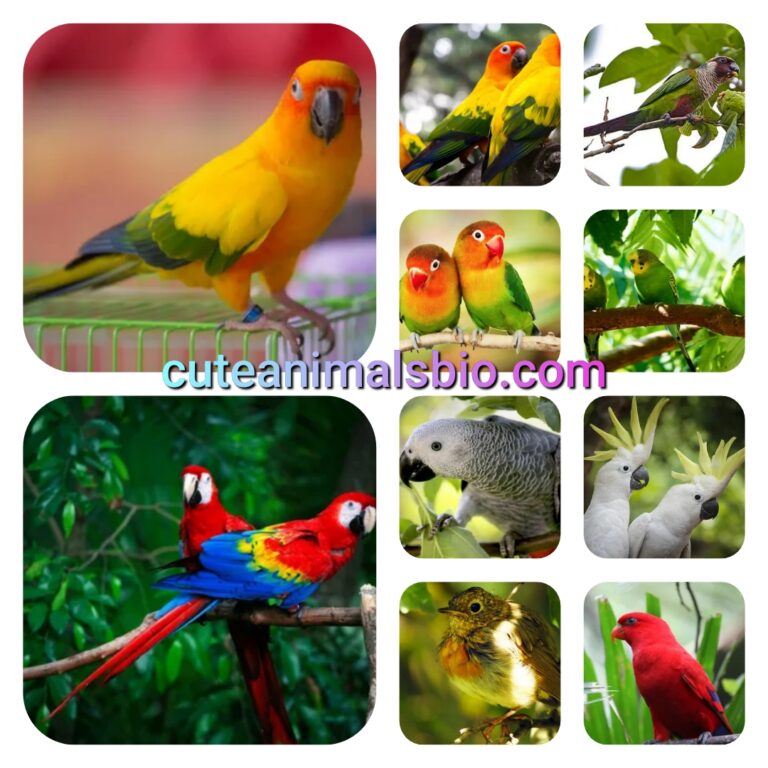Top 10 Cutest Birds
1 Atlantic Puffin

The Atlantic Puffin is a veritable charmer of the bird kingdom, with its absurdly large beak and penguin-like waddle. The majority of these interesting black-and-white seabirds’ lives are spent at sea, yet they do come ashore for a brief period in the spring and summer to engage in breeding. Get ready to explore the world of the Atlantic Puffin
Leading Both a High and a Low Life:
Journeys at Sea: Puffins dive for tiny fish, such as sand eels and herring, throughout most of their lives out at sea. They can swim up to 200 feet and use their wings as flippers. They are really good swimmers. Top 10 Cutest Birds In The World
Cliffside Colonies: During the mating season, these birds migrate a great distance and settle in large colonies on rocky islands and cliffs in the North Atlantic. Puffin burrows are scattered throughout the coast from Canada to Norway and south of Spain.
Builders of Burrows: Puffins excavate new burrows or reuse pre-existing ones to construct comfortable subterranean nests furnished with grass and feathers.
Devoted Parents: The solitary chick’s breeders share responsibility for feeding and incubating it. They tirelessly return with their wings, full of fish, which is a charming and magnificent sight.
A Bird with Several Tails: Top 10 Cutest Birds In The World
Flapping Frenzy: Puffins are astoundingly fast fliers, reaching speeds of 55 mph by flapping their stubby wings up to 400 times per minute, even though their airborne maneuvers may not win awards for elegance.
The Wonders’ Beak: Its distinctive orange and yellow beak has a functional purpose. Its hue varies with the seasons; in the winter months, it becomes more vivid during breeding. Additionally, it has unique spines that enable it to cling to slippery fish.
Characters of Puffins: These gregarious birds are highly talkative, exchanging sounds such as trills, squeaks, and
Extra Puffin Information:
Due to their humorous look and demeanor, puffins are often referred to as “clowns of the sea” and “sea parrots.
They have beaks that can simultaneously handle up to 12 fish.
Year after year, they might return to the same companion and reuse the same burrow.
The oldest Atlantic Puffin ever observed made it to 41 years old.
2 Goldfinch

The goldfinch is a famous bird all across the world because of its vivid feathers and upbeat singing. These vibrant tiny finches adorn gardens, yards, as well as homes, enticing people with their vivid energy and splendor. Come along as we investigate the goldfinch’s world
Dazzling Guys: With their vivid yellow bodies, black wings and caps, and white wing bars, male goldfinches, particularly in the spring and summer, steal the show. In winter, this striking ensemble fades to a darker olive-streaked brown. Top 10 Cutest Birds In The World
Soft Beauty: Olive-brown upperparts and creamy-yellow undersides are the hallmarks of the more muted beauty displayed by females and non-breeding males. The conspicuous conical beak and notched tail of their finch family are shared by both sexes.
Feathery Style: Goldfinches change from their breeding to non-breeding plumage twice a year through molting. They may seem very uneven and messy throughout this procedure!
A Seed and Song Life:
Experts in seeds
Goldfinches are mostly herbivores who eat a wide range of seeds, particularly from sunflowers, dandelions, and thistles. Their quick beaks are ideal for snatching these costly delicacies.
Acrobatic Feeders: Always on the hunt for their next delectable seed, these nimble birds hang perpendicular to the ground, clinging to swinging stems, and move easily through dense vegetation.
Melodious Minstrels
Skilled vocalists and goldfinches fill the air with cheery, twittering tunes. Their lively musical repertoire is enhanced by their beautiful calls, which frequently replicate the sounds of other birds.
Nesting and Society:
Chic Nests: Goldfinches construct comfortable, cup-shaped nests on trees or bushes that are frequently hidden by foliage. They build a secure sanctuary for their eggs and chicks out of a variety of materials, like moss, leaves, and twigs.
Devoted Parents: Raising their children is a shared obligation between both parents. They carefully carry food back to the hungry chicks while taking turns incubating the eggs.
Flocking Together: Following the mating season, vast, migratory flocks of goldfinches develop. These social groupings can number in the hundreds, and they make stunning visual displays with their whirling, undulating flying patterns
All the goldfinches on Earth:
Worldwide Distribution: There are several species of goldfinches in the genus Carduelis, which are distributed across Europe, Asia, and North America. While the European Goldfinch has been brought to other areas, such as Australia and New Zealand, the American Goldfinch is a common sight across the continent.
Conservation Concerns: Although not in danger of extinction at the moment, certain groups of goldfinches are facing difficulties due to habitat degradation and competition from other bird species. Their continuing success may be ensured by habitat restoration initiatives and bird-friendly gardening techniques.
Individuals and Goldfinches:
Inspiration and Symbols: For a very long time, these birds have been important to cultures. They frequently stand for resilience, happiness, and hope and may be seen in literature, art, and even heraldry. Top 10 Cutest Birds In The World
Visitors in the backyard: Attending feeders with ease, goldfinches are attracted to sunflower germ. By offering these tasty nibbles, you may invite these vibrant birds to visit your home and take in their lovely colors and mischievous antics.
3 Rainbow Lorikeet
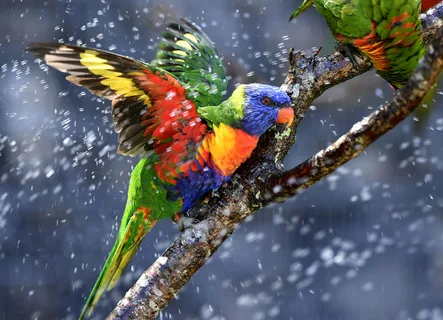
The Rainbow Lorikeet, with feathers as vibrant as a tropical sunset, is a genuine marvel of the bird kingdom. These stunning parrots, which are indigenous to Australia and the surrounding islands, enthrall onlookers with their vibrant colors, silly antics, and breathtaking aerial performances.
Turning one’s head Hues: The Rainbow Lorikeet’s plumage is without a doubt its most remarkable characteristic. Their bodies are a vibrant tapestry of blues, greens, yellows, reds, and oranges, making them among the most colorful birds on the planet.
Variations: Although both sexes have a bright color scheme, men typically have a little stronger color, especially on the head and chest.
The Masters of the Air:
Experts in Acrobatics: Rainbow Lorikeets are nimble and acrobatic fliers that can move through the air with remarkable speed and accuracy. Their tongues with brush tips are used to reach for nectar-rich blooms, and they frequently hang upside down on trees.
Fast and Furious: With their vibrant plumage blazing against the sky, these feathered rockets may soar through the air in big, raucous groups at up to 50 miles per hour.
Community Spirits:
Rainbow Lorikeets are gregarious birds that may gather in sizable flocks consisting of several hundred individuals. These gregarious flocks put on a show of feathery fun with their loud cries, aerial acrobatics, and group feeding. Top 10 Cutest Birds In The World
Lifelong Partnerships: Strong couples of these monogamous parrots mate for life. To construct nests, care for the young, and protect their area, they cooperate.
Conservation Concerns: Despite now steady populations, rainbow lorikeets, are threatened by things like habitat loss from deforestation and competition from invasive species. The main goals of conservation efforts are to preserve their essential ecosystems and increase public knowledge of their significance in ecology.
4 Indigo Buntings
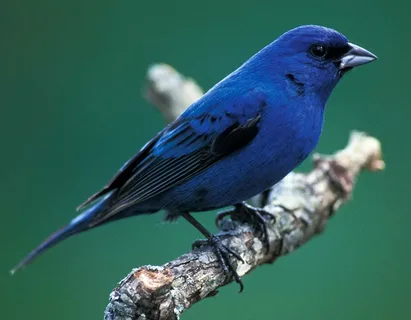
Unveiling the Indigo Bunting: A Jewel of the Songbird World
Speaker’s Notes
Greetings, lovers of the outdoors and birds! Today, we set out to explore the beauties of the little songbird known as the Indigo Bunting, which enthralls with its vivid color and entrancing singing. Prepare to be enthralled by its beauty, fascinated by its quirks, and motivated by its tenacity.
Slide 2 Title:
A Feathered Gem: Revealing the Look of the Indigo Bunting
Gorgeous Men: Especially in the breeding season, the vivid cerulean blue plumage of male Indigo Buntings steals the stage. Their tail and wings, with their black tips and margins, provide contrast.
Subdued Elegance: With brown upperparts and lighter brown undersides, females and non-breeding males have a more understated attractiveness. The characteristic small, conical beak and short tail of buntings are shared by both sexes.
A Change of Seasons: Twice a year, Indigo Buntings shed their breeding plumage and acquire non-breeding plumage. They may look uneven and unruly during this period, much like nature’s ongoing construction!
A Symphony of Song and Seed: Exploring the Indigo Bunting’s Life
A Musical Symphony and Seed: Examining the Life of the Indigo Bunting
Sweet Minstrels: During the breeding season, especially, lively, twittering melodies are heard from Indigo Buntings. They can replicate the sounds of other birds in their repertoire, which gives their musical presentations a fun edge. Top 10 Cutest Birds In The World
Experts in Seeds: These birds are mostly vegetarian and feed mostly on seeds, especially those from sunflowers, dandelions, and thistles. Their quick beaks are ideal for snatching these priceless delicacies.
Seekers of Nesting Nooks: Indigo Buntings construct comfortable, shaped like cup nests in trees or bushes, sometimes hidden by surrounding vegetation. They build a secure sanctuary for their fertilized eggs and young out of moss, leaves, and twigs.
Devoted Parents: Raising their children is a shared obligation between both parents. They meticulously bring back the eggs after taking turns incubating them.
5 Blue jay

The Blue Jay is a widely recognized bird in North America, distinguished for its vibrant feathers and loud vocalizations. These astute amaze onlookers with their colorful personalities, elaborate social networks, and astounding flexibility. Now let’s tour the incredible universe of the Blue Jay.
A Lightweight Style Icon:
Amazing Pair: The cobalt blue feathers, white underparts, and striking black markings on both the sexy male and female Blue Jays are a gorgeous combination. Their unique crests give them a royal look.
Feathery Fashion Show: The blue coloration’s intensity varies according to the subspecies and even individual birds, but the overall color scheme stays the same.
Molting Metamorphosis: These birds change from their bright breeding plumage to a somewhat duller non-breeding outfit twice a year during their two molts.Top 10 Cutest Birds In The World
Leaders of the Woods:
Brainpower Bonanza: Blue Jays are among the smartest birds in the avian kingdom, and their intellect is well known. They have outstanding memory, problem-solving abilities, and even tool use.
Corn Aficionados: By storing acorns and unintentionally establishing trees all throughout their range, these industrious birds contribute much to the health of forest ecosystems.
Master Mimics: In addition to their distinctive cries, blue jays can imitate a variety of different birds, predators, and even mechanical noises with their amazing vocal palette.
Family, food, and life:
Nest Building Bonanza: Blue Jays, both male and female, collaborate to construct robust, cup-shaped nests on trees, covering these structures with soft materials such as feathers and grass.
Devoted couples: These birds establish monogamous couples and work together to raise their young, with both parents contributing to the incubation and upbringing of the young.
The blue jay is an omnivorous opportunistic feeder that eats a variety of foods, including acorns and nuts, seeds, pests, tiny fruits, and sometimes even an egg or youngster.
6 Baltimore Oriole

The Baltimore Oriole, or Icterus galbula, is a magnificent songbird that is renowned for its vivid feathers and lovely scream. It is a widespread migratory species in eastern North America, adding flaming orange and black color to environments.
Look:
Males: every part of them is a blazing orange color, except their sleek black head.
Wear a striking white wing bar to lend it a refined look.
possess a robust, conical beak that is ideal for catching fruit and insects.
Females: With a more subdued color scheme, they displayed their grayish head and back together with their yellowish-orange underparts.Top 10 Cutest Birds In The World
Easily distinguished from Bullock’s Orioles by their two prominent white wing bands.
Both sexes:
Both have long tails and slim builds, making them perfect for darting between trees.
Length: around 7-8 inches; wingspan: 11-14 inches.
Behavior and Habitat:
The Baltimore Orioles prefer parks, open forests, and fringes of forests.
Orioles are talkative birds that, particularly in the mating season, fill the space around them with their unique hummed melodies. Males utilize their beautiful songs to entice females and protect their property.
Interesting Information
The Baltimore Oriole was picked as Maryland’s state bird due to its similarity to the colors of the coat of arms of the biblical Baltimore family.
These birds are expert weavers; they create intricate hanging nests from bark strips, plant fibers, and sometimes yarn or thread.
Orioles migrate, spending the wintertime in Central and South America and the summers in North America.
7 Carolina wren

The Carolina Wren, Another jewel of North America, this brisk little songbird adds appeal to gardens, woodlands, and even cities. I can tell you the following about them:
Look:
Compact, round body: Often referred to as ” shaped, these are the second biggest wrens in the US, at approximately 5 inches in length.
Rich, reddish-brown tops: Earthy and warm, with a hint of fall foliage.
Underparts: buff-orange; a brilliant contrast to the darker top.
Their long, white brow stripe gives them an inquisitive appearance, like to a noticeable pair of glasses.
Dark bill: Slim and downward-curving, ideal for burrowing about in cracks to locate insects.
A distinguishing characteristic that gives their movements bounce and vigor is their long, frequently cocked tail.
Behavior and Habitat:
Found throughout the eastern portion of North America, extending from Ontario to Mexico and all points in between.
Prefer deep cover: They can find cover and hunting grounds in backyard brush piles, gardens, thickets, and woodland areas.
Always on the go, they jump through shrubbery, climb branches, and explore every nook and corner with an inquisitive and active nature.
Melodic and loud singers: Known for its bubbly “teakettle-teakettle” sound or quick bursts of trills and whistles, the male singer’s song are heard throughout the spring and summer. Although their repertoire is simpler, females nonetheless participate in the vocal chorus.
Innate insectivores: Their main diet consists of caterpillars, bugs, scorpions, and other creepy crawlies, however, they may occasionally graze on fruits and berries.
Interesting Information
South Carolina’s official bird is: The people of the state were captivated by their vivid colors and vivacious personalities.
Dedicated parents, birds may construct many nests and develop younglings several times in a warm year. Capable of raising many broods in a season.
Brave and inquisitive: Do not be shocked if one approaches you on your lawn and looks at you with its beady eyes.
8 Dusky Lory
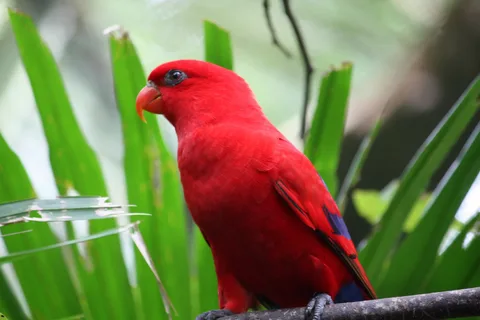
A fascinating parrot native to New Guinea and the neighboring islands is the Dusky Lory (Pseudeos fuscata). What makes this feathered marvel so unique is as follows
There are two color phases: the “yellow” phase has vivid yellow in place of orange, and the “orange” phase has a golden-brown head, orange collar, and white rump.
Overall darkish: Their appellation comes from the darkish brown wing and torso, which contrast with their vivid accents.
Compact and having short tails: Although they are not the largest parrots—they are just around 10 inches long—their vibrant personalities certainly make an impression.
Stunning features: A vivid orange or red beak offers a flash of color across the black plumage. They may be further distinguished by the bare golden epidermis around the bottom of the lower part of the jaw.
Red irises: The flaming intensity of their eyes adds to their expressiveness.
Forest dwellers: At heights of up to 7,875 feet, they may be found thriving in forests, mangrove forests, and tropical and subtropical rainforests.
Extremely gregarious: Dusky Lories rarely fly or feed alone, instead congregating in loud, voluminous flocks. Their deafening cries and piercing shrieks reverberate over the woodland canopy.
Omnivorous diet: They use their brush-tipped tongues to extract the delicious goodness a variety of fruits, seeds, buds, nectar, grains, and even pollen.
Playful acrobats:
It’s a real joy to watch them swooping through the trees, flipping over, and doing graceful moves.
Natural clowns:
They are endearing due to their humorous behaviors, which include head bobbing and lighthearted exchanges.
Astute mimics
: Capable of imitating human speech and other noises, they are fascinating companions, however, not as easily kept as other parrot species.
Population stability: Thankfully, there is no imminent danger to the Dusky Lory population, which is thought to be stable
9 European Robin

The European Robin (Erithacus rubecula), sometimes called the Robin Redbreast, is a delightful little songbird network that sings its way through the gardens and forests in portions of North Africa, parts of western Asia, and Europe. What renders our feathery companion so unique is as follows:
Slim and full:
With a spherical head and a plump body, they are little, but well-shaped, lasting around 5.5 inches in length.
Unique color scheme: The faces and breasts of both the sexes and female robins have a firing orange hue, contrasted with brown upperparts and a pale belly. Their most identifiable characteristic is this bright orange patch that resembles a small fire.
Subtle differences
: If you look closely, you can see that the male robin’s breasts are more brightly colored than the female’s. The plumage of juveniles is mottled brown and buff, with traces of orange progressively showing as they become older.
Resident adaptability:
Robins like a range of environments, including gardens, parks, deep forests, and even urban locations. Except for those in the extreme north who move south for the winter, they are typically stationary throughout their range.
Explorers that like the ground:
They graze and hop on the ground for a large portion of their time, cocking their tails and flicking their wings in the process as they look for berries, worms, and insects.
Sweet-sounding vocalists:
Even in the winter, when they sing to protect their territory, people are familiar with the sound of their lovely, high-pitched singing. Trills, warbles, and even bird mimicking are all part of their repertory.
10 Crimson Rosella
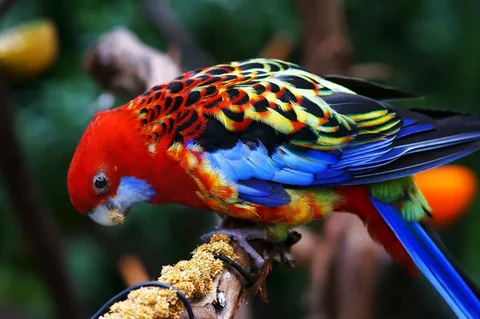
Usually seen in small groups of 10 to 20 birds, Rosellas are gregarious. Because of their great adaptability, they may live happily in grasslands, woods, and sometimes urban areas. Their primary food sources are fruits, nuts, seeds, and pests, which they get by deftly scaling trees and branches
These stunning birds make a range of cries, such as yelling, squawks, and chirping noises. They are also quite talkative. In addition to being fun and clever, they are well-known for their naughty antics and acrobatic acrobatics. Scarlet are popular pets because of their vivid colors, endearing personalities, and comparatively low maintenance needs. But it’s crucial to remember that they are wild creatures with unique requirements, and you should only keep them as animals if you can give them the space and attention they need.

